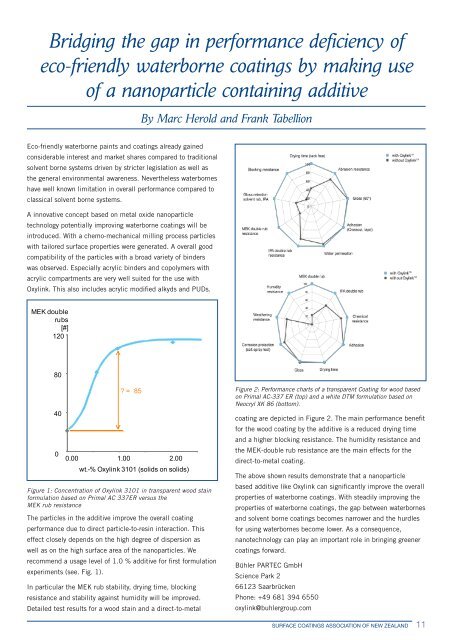Brushstrokes - October 2011 - Surface Coatings Association of New ...
Brushstrokes - October 2011 - Surface Coatings Association of New ...
Brushstrokes - October 2011 - Surface Coatings Association of New ...
Create successful ePaper yourself
Turn your PDF publications into a flip-book with our unique Google optimized e-Paper software.
Bridging the gap in performance deficiency <strong>of</strong><br />
eco-friendly waterborne coatings by making use<br />
<strong>of</strong> a nanoparticle containing additive<br />
Eco-friendly waterborne paints and coatings already gained<br />
considerable interest and market shares compared to traditional<br />
solvent borne systems driven by stricter legislation as well as<br />
the general environmental awareness. Nevertheless waterbornes<br />
have well known limitation in overall performance compared to<br />
classical solvent borne systems.<br />
A innovative concept based on metal oxide nanoparticle<br />
technology potentially improving waterborne coatings will be<br />
introduced. With a chemo-mechanical milling process particles<br />
with tailored surface properties were generated. A overall good<br />
compatibility <strong>of</strong> the particles with a broad variety <strong>of</strong> binders<br />
was observed. Especially acrylic binders and copolymers with<br />
acrylic compartments are very well suited for the use with<br />
Oxylink. This also includes acrylic modified alkyds and PUDs.<br />
MEK double<br />
rubs<br />
[#]<br />
120<br />
80<br />
40<br />
0<br />
? = 85<br />
0.00 1.00 2.00<br />
wt.-% Oxylink 3101 (solids on solids)<br />
Figure 1: Concentration <strong>of</strong> Oxylink 3101 in transparent wood stain<br />
formulation based on Primal AC 337ER versus the<br />
MEK rub resistance<br />
The particles in the additive improve the overall coating<br />
performance due to direct particle-to-resin interaction. This<br />
effect closely depends on the high degree <strong>of</strong> dispersion as<br />
well as on the high surface area <strong>of</strong> the nanoparticles. We<br />
recommend a usage level <strong>of</strong> 1.0 % additive for first formulation<br />
experiments (see. Fig. 1).<br />
In particular the MEK rub stability, drying time, blocking<br />
resistance and stability against humidity will be improved.<br />
Detailed test results for a wood stain and a direct-to-metal<br />
By Marc Herold and Frank Tabellion<br />
Figure 2: Performance charts <strong>of</strong> a transparent Coating for wood based<br />
on Primal AC-337 ER (top) and a white DTM formulation based on<br />
Neocryl XK 86 (bottom).<br />
coating are depicted in Figure 2. The main performance benefit<br />
for the wood coating by the additive is a reduced drying time<br />
and a higher blocking resistance. The humidity resistance and<br />
the MEK-double rub resistance are the main effects for the<br />
direct-to-metal coating.<br />
The above shown results demonstrate that a nanoparticle<br />
based additive like Oxylink can significantly improve the overall<br />
properties <strong>of</strong> waterborne coatings. With steadily improving the<br />
properties <strong>of</strong> waterborne coatings, the gap between waterbornes<br />
and solvent borne coatings becomes narrower and the hurdles<br />
for using waterbornes become lower. As a consequence,<br />
nanotechnology can play an important role in bringing greener<br />
coatings forward.<br />
Bühler PARTEC GmbH<br />
Science Park 2<br />
66123 Saarbrücken<br />
Phone: +49 681 394 6550<br />
oxylink@buhlergroup.com<br />
SURFACE COATINGS ASSOCIATION OF NEW ZEALAND 11


